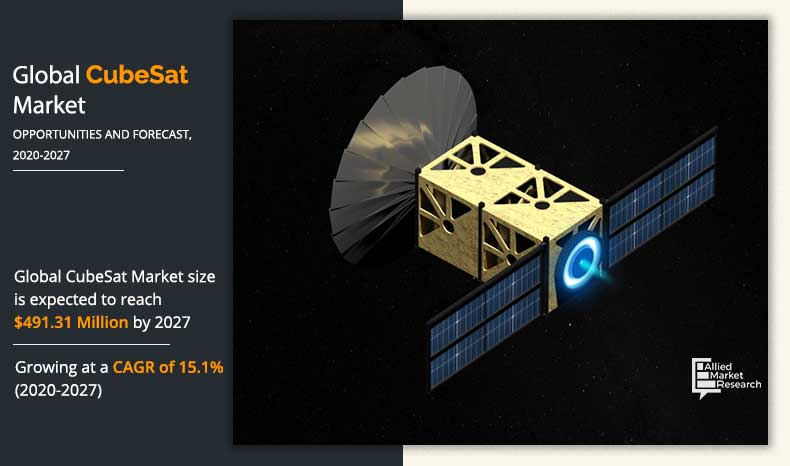Prospects in the CubeSat Market
by Mayank Halmare
Pune, India, April 6, 2021--CubeSats are miniaturized cubical-shaped small satellites measuring 10x10x10 cm3 - approximately the dimension of the popular Rubik’s cube and weighs around 1 kg. A CubeSat can be used as a single unit (1 U) or in clusters of several units or U’s (1U, 2U, 3U, 6U, 12U, and others). According to Allied Market Research, the global CubeSat market was valued at US$ 184.11 million in 2020, and is estimated to grow at a CAGR of 15.1% during the forecast period (2020-2027).
CubeSats have revolutionized the space market by proving an efficient solution for the economical launches into space and in conducting various technology demonstrations, scientific researches, Earth exploration, and other missions. Moreover, these satellites are exceedingly used by commercial businesses, government, military, and non-profit organizations as they are quite simple to design, develop, and launch as compared with the traditional satellites.
CubeSat Industry Dynamics
 CubeSats are a type of nanosatellites, defined by the CubeSat Design Specification (CSD), unofficially known as the CubeSat standard. These satellites are much smaller in size and lower in weight as compared to the conventional satellite. Making small satellites as per the CubeSat standards results in cutting down costs associated with the research and technical development stages. Moreover, the time required to build and position one CubeSat in the orbit takes less than 8 months, which is substantially lesser than the traditional or large satellites. Attributed to these benefits, the demand for CubeSat is increasing significantly especially for commercial applications such as agriculture, forestry, energy, media & entertainment, civil engineering, traffic monitoring, and archaeology. For instance, ESA launched a CubeSat GomX-3 built by GomSpace in October 2015. Since its launch, the GomX-3’s unique helical antenna has identified lots of signals transmitted from aircraft, which helped to build a comprehensive map of worldwide air travel traffic.
CubeSats are a type of nanosatellites, defined by the CubeSat Design Specification (CSD), unofficially known as the CubeSat standard. These satellites are much smaller in size and lower in weight as compared to the conventional satellite. Making small satellites as per the CubeSat standards results in cutting down costs associated with the research and technical development stages. Moreover, the time required to build and position one CubeSat in the orbit takes less than 8 months, which is substantially lesser than the traditional or large satellites. Attributed to these benefits, the demand for CubeSat is increasing significantly especially for commercial applications such as agriculture, forestry, energy, media & entertainment, civil engineering, traffic monitoring, and archaeology. For instance, ESA launched a CubeSat GomX-3 built by GomSpace in October 2015. Since its launch, the GomX-3’s unique helical antenna has identified lots of signals transmitted from aircraft, which helped to build a comprehensive map of worldwide air travel traffic.
Moreover, CubeSats are being used increasingly for earth observation, owing to their low cost and short development cycle. CubeSat systems equipped with different spectral, radiometric, and spatial sensors have been launched over the years for optical Earth observation and related services. For instance, Planet Labs Inc. launched Flock-4e’1 to Flock-4e’9, constellations in 2020. Moreover, Hera-1 by Hera Systems (2019), Tianyan-02 by ADA Space (2019), and NAPA-1 by Royal Thai Air Force (2020) were launched to collect and analyze Earth’s resources.
In addition, the use of CubeSat is significantly growing in non-profit organizations, such as universities or colleges, which design and develop CubeSats for research or experimentation purposes. Governments and space organizations across the globe are supporting these CubeSat launches aimed at the enhancement of research applications undertaken by research institutions. For instance, the National Aeronautics and Space Administration (NASA) has announced CubeSat launch Initiative through which NASA provides CubeSat developers a low-cost pathway for small satellite payloads developed by non-profit organizations by accommodating them in NASA’s upcoming launches.
Some of the prominent players that offer geospatial technologies for defense and security applications are Planet Labs Inc., GomSpace, AAC Clyde Space, Endurosat, Tyvak Nano-Satellite Systems, Inc., Surrey Satellite Technology Limited, and others. The companies operating in this market are focusing on partnership and agreement strategies to improve their market share. For instance, in July 2020, GomSpace and ESA signed a contract for the implementation of Juventas CubeSat in support of the Hera mission. Moreover, in September 2020, AAC Clyde Space, SAAB AB, and ORBCOMM Inc. entered into a partnership to develop the next generation of space-based VHF Data Exchange System (VDES) system.
Stringent government regulations are a major challenge for the growth of the CubeSat market. The legal issues pertaining to the restrictions on data collection, location privacy, intellectual property rights, and use & storage of geospatial information and data limit the scope of the CubeSat market. For instance, the transmission of radio signals to or from a CubeSat involves regulatory approval in the U.S. Regardless of orbit or the ultimate destination, the necessity to obtain a license applies to all CubeSats that transmit signals. Besides, the procedures and measures required for obtaining the license are spread between numerous rules & regulations issued by the domestic regulatory bodies and are also subjected to further regulations made mandatory by the international agreements. The timeline for obtaining the satellite and Earth station licenses are usually significantly time-consuming than the development cycle for a CubeSat project. These factors can affect the project duration. Apart from regulations, the small size of CubeSats limits the accommodation of the volume of propulsion, payload, and other subsystems, thereby posing a challenge for CubeSat manufacturers.
Key Trends
Advanced technologies, such as artificial intelligence, big data, and machine learning, have emerged as the main trends in the earth observatory sector. These technologies play a vital role in the effective analysis of satellite data. The capability of AI is leveraged by the key players to allow systems to derive insights and make the right decisions using raw data sets with negligible human contribution. For instance, the European Satellite Association (ESA) is planning to launch a CubeSat, which is equipped with onboard artificial intelligence to improve the efficiency of sending Earth observation data back to Earth. Moreover, the machine learning algorithm provides more accurate insights to analyze the satellite imagery of any resolution. For instance, in October 27th, 2020, Google and the National Oceanic and Atmospheric Administration (NOAA) linked up to cooperatively steer machine learning and artificial intelligence driven pilot projects that will allow the advancement of the agency’s weather predicting, environmental monitoring, and climate research capabilities.
Moreover, the companies operating in the CubeSat ecosystem are coming up with advanced subsystems for the efficient working of CubeSats. For instance, GomSpace is providing solar panels for CubeSats. The energy collected from the solar panels that are exposed to direct solar radiation is the source of power for CubeSats. The batteries are installed together with the solar panels to collect the energy, which can be used while the satellite repeatedly passes through the shadow of the Earth.
COVID-19 Impact
The COVID-19 crisis is creating uncertainty in the market, slowing down the supply chain, falling business confidence, and increasing panic among the customer segments. Governments of different regions have already announced total lockdown and temporarily shutdown of industries, which adversely affected the overall production and sales. As the COVID-19 pandemic has swept the world, many industries are struggling to stay afloat, including the satellite industry. The companies involved with space are reacting differently to the new situation.
Digitalization is on the rise across the globe, and satellite data and signals play an increasingly crucial role in the effective functioning of societies and their economic growth. The space sector has witnessed considerable growth over the years and has resulted in increased levels of start-ups participating in the market. Moreover, owing to the COVID-19 crisis, this trend is anticipated to slow down the business activities of small & medium-sized firms that constitute the majority of commercial players in the space sector. If the high costs to enter the sector are considered, the detrimental economic impacts caused due to the pandemic may lead to more industry concentration and might result in the elimination of smaller firms.
The COVID-19 crisis has prompted CubeSat operators across the globe to abandon mission operations centers.
However, as the demand for crisis monitoring has increased significantly, the players in the CubeSat ecosystem are establishing remote operations access for smooth functioning. For instance, University of California, Los Angeles (UCLA), which is operating twin Electron Losses and Fields Investigation (ELFIN) CubeSat, has established the remote operating access for the satellite.
Despite the negative impact of COVID-19, the CubeSat industry managed to perform moderately and several CubeSats were launched in 2020 such as DeMi, TechEdSat-10, Gundam, TDO-2, Flock-4e, Flock-4v constellations, and SpaceBee. This steady growth in CubeSat missions can be attributed to the low cost but efficient operations of the CubeSats and the rising participation of private players in the market. Moreover, CubeSats continued to offer an effective solution for academic study across the world. For instance, Quetzal-1 was launched in April 2020 for educational training missions. The space sector, like all others, has been impacted by the spread of the pandemic and the consequent slowdown of the global economy, but the CubeSats market has managed to tackle the negative impacts of the pandemic, owing to the increase in capabilities of the cost-effective small satellites over the years. With the initiation of vaccination around the globe, the COVID-19 pandemic is anticipated to be eliminated gradually over the years, and the space sector is expected to attain a considerable leap in the near future.
For more information on research on the Cubesat Market go to: https://www.alliedmarketresearch.com/cubesat-market-A09399
---------------------------------
 Mayank Halmare is a seasoned market research and consulting professional. He has experience of working on various successful consultation projects with well-known brands in Aerospace and Defense industry such as Sierra Nevada Corporation, Airbus, Planet Labs Inc., and others. His expertise has helped clients across the globe to formulate successful business strategies which contributes significantly in growth of the company. He holds a bachelor’s degree in Mechanical engineering and Master’s degree in MBA from one of the topmost educational institute. He can be reached at: mayank.halmare@alliedanalytics.com
Mayank Halmare is a seasoned market research and consulting professional. He has experience of working on various successful consultation projects with well-known brands in Aerospace and Defense industry such as Sierra Nevada Corporation, Airbus, Planet Labs Inc., and others. His expertise has helped clients across the globe to formulate successful business strategies which contributes significantly in growth of the company. He holds a bachelor’s degree in Mechanical engineering and Master’s degree in MBA from one of the topmost educational institute. He can be reached at: mayank.halmare@alliedanalytics.com






